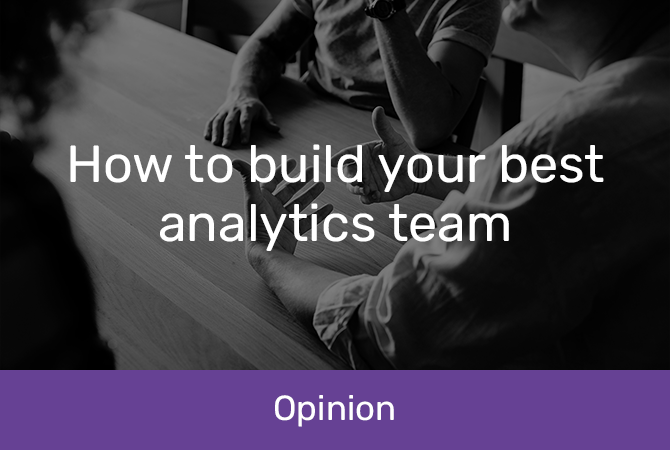
How to build your best analytics team
With a PWC CEO survey referring to the job market for data scientists and analytics as an area of ‘hyper growth’, it’s clear that many organisations are staffing up their analytics teams — but is there a best practice way to do it?
Whether it’s to improve the quality and speed of your decision making, gain deeper customer insight or drive efficiencies into business operations, the common denominator for success is an effective analytics team. Many studies show the concrete benefits of becoming ‘analytics enabled’, but what is much less clear is how to build that capability within an organisation.
![]() A key first hurdle for many organisations is deciding exactly what their analytics team should look like. Put simply, the size and structure of your team will depend primarily on what you are trying to achieve, your chosen business model for delivering analytics value, and how you define ‘the team’. Larger organisations usually have two cyclical dynamics at play and your team situation often depends on where you sit as an organisation within these two cycles:
A key first hurdle for many organisations is deciding exactly what their analytics team should look like. Put simply, the size and structure of your team will depend primarily on what you are trying to achieve, your chosen business model for delivering analytics value, and how you define ‘the team’. Larger organisations usually have two cyclical dynamics at play and your team situation often depends on where you sit as an organisation within these two cycles:
1. Cycling from outsource to in-house and back, which is usually driven by three factors:
- a belief that establishing an internal team will deliver the same value to the business as external specialist expertise, which is then followed by a culling of the internal resource if the value does not eventuate quickly enough or for sustained periods
- changes to headcount limits or the current climate about ‘permanent’ OPEX costs vs temporary OPEX costs
- a policy decision that analytics is ‘too strategic to be outsourced', a position that can be countered by the accelerated progress and broader viewpoints brought to the table by partnering with external experts
2. Cycling from an organisational centre of excellence to distributed analytics expertise and back again, usually driven by two factors:
- When analytics expertise is distributed, people wish that more sharing, learning, and efficiency could take place – so they centralise it. Once that’s done, they start to feel that the team is disconnected from the business units – so they decentralise
- High quality decentralisation is not scalable because it relies on too wide a skillset being held by the person or small team working tightly with the business unit, and leads to pockets of excellence which are not leveraged across the organisation
In our experience, you can mitigate both of these cycles by locking yourself in the following dynamic:
- A hybrid model where all business-as-usual and common specialist ad hoc work can be covered by the internal team, with an outsource partner providing less-used specialist expertise and overflow capacity
- A centre of excellence with investment in a translation layer of analytically-aware people who understand how to evaluate business needs and translate them into analytics projects (and back)
Developing your capacity
If you can afford an analytics team of more than eight and some budget for a partner, the hybrid model and centre of excellence combination is the most likely to give you a successful outcome. When looking at your internal capability, understanding what kinds of skills you need is just as important as knowing how many people you’ll require. This will change over time as your business needs change and your general analytics capability rises — not just in the analytics team, but also in the business users who are exposed to addictive analytics.
Development of capability usually follows three phases; it is very difficult to leap ahead and almost impossible to leap ahead efficiently:
![]() 1. Heavy focus on data manipulation, automation of manual tasks and requirement gathering
1. Heavy focus on data manipulation, automation of manual tasks and requirement gathering
2. Value added through insights and better information for decision makers
3. Value added through automated decisions and analytics that are directly operationalised into business processes
When it comes to focusing the team on areas that will produce value, it’s easier at the top end — so identify two or three really important analytics projects and let them get started (see here for how to select those). Build your capability to deliver on those use cases and then expand from there. This ensures you don’t build capability you don’t need. After the big wins, you will still achieve a lot of value from your analytics team, but it will require more effort directed towards defining exactly what that value is and prioritising projects.
This is where an outsource partner comes in handy. They will typically have been exposed to organisations in similar situations to your own, and will be experienced in identifying and defining the value opportunities in your business. If your governance process is good, then you will achieve a strong return on your investment without having to worry about fitting these projects into your analytics team workflow.
Keys to success here are central visibility and permission for business units to engage the partner if their work is not getting into the analytics team's priorities. There should always be a checkpoint near the end of the scoping process to determine if the internal team should do the work or not. If you want to learn more about outsourcing your analytics capacity, talk to the team at Datamine today.














































